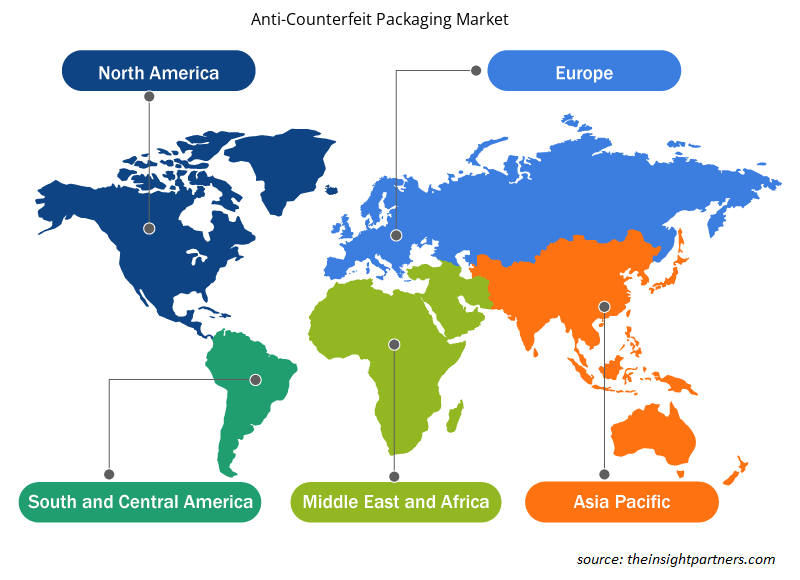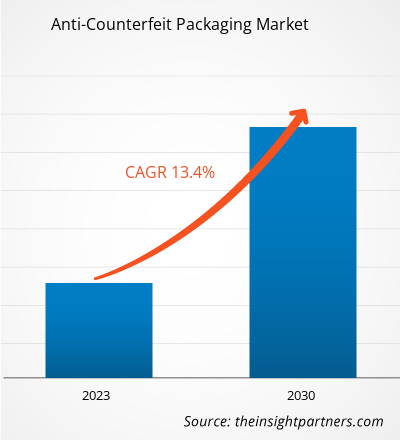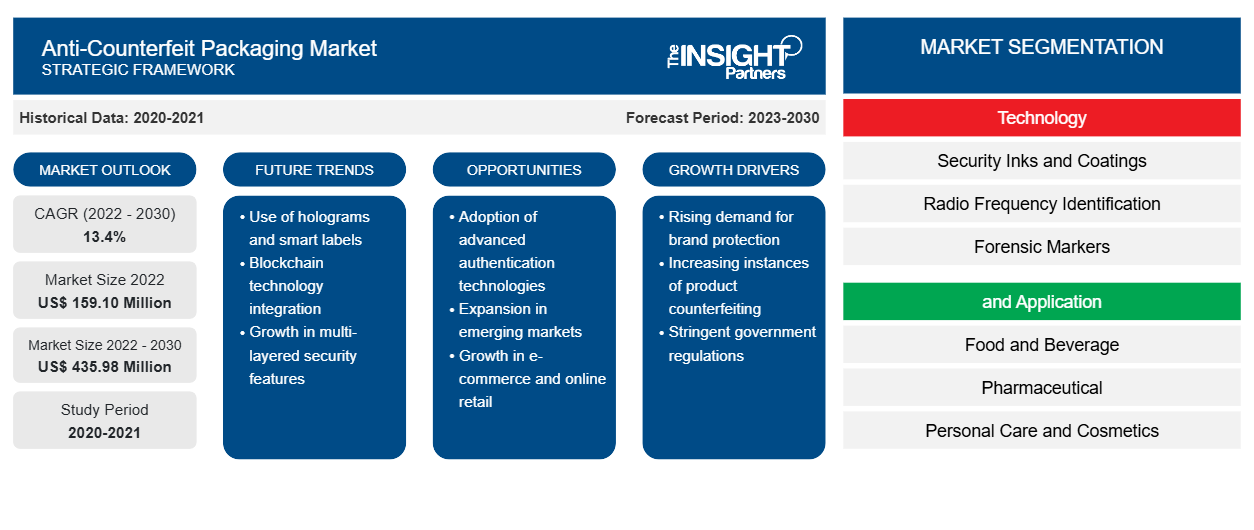[تقرير بحثي] من المتوقع أن ينمو حجم سوق التغليف المضاد للتزييف من 159.10 مليون دولار أمريكي في عام 2022 إلى 435.98 مليون دولار أمريكي بحلول عام 2030؛ ومن المتوقع أن يسجل معدل نمو سنوي مركب بنسبة 13.4٪ من عام 2022 إلى عام 2030.
رؤى السوق ووجهة نظر المحلل:
يشير مصطلح التغليف المضاد للتزييف إلى تطبيق تدابير وتقنيات مختلفة لحماية المنتجات من حوادث التزييف أو التقليد أو العبث. وتشكل المنتجات المقلدة مخاطر كبيرة على صحة المستهلك وسلامته وسمعة العلامة التجارية. وتهدف حلول التغليف المضاد للتزييف إلى توفير ميزات المصادقة والتتبع والأمان التي تساعد في تحديد المنتجات الأصلية وردع التزييف. وغالبًا ما تنطوي هذه الحلول على استخدام تقنيات متقدمة مثل الصور المجسمة وأكواد التسلسل الفريدة والملصقات الواضحة للتلاعب وعلامات تحديد الترددات الراديوية أو الأحبار غير المرئية. وهناك طلب متزايد على التغليف المضاد للتزييف في الصناعات الدوائية والأغذية والمشروبات والمنسوجات والملابس والكهرباء والإلكترونيات. ويدفع هذا العامل بشكل كبير سوق التغليف المضاد للتزييف في جميع أنحاء العالم.
محركات النمو والتحديات:
المنتجات الصيدلانية المقلدة هي نسخ مزيفة أو غير مصرح بها من الأدوية الأصلية التي يتم تعمد وضعها بشكل خاطئ أو غشها أو دون المستوى المطلوب من حيث الجودة. وتشكل المنتجات الصيدلانية المقلدة مخاطر كبيرة على الصحة العامة والسلامة، مما يؤدي إلى قلق متزايد بين الهيئات التنظيمية وشركات الأدوية والمستهلكين. وصناعة الأدوية معرضة بشكل خاص للتزوير بسبب القيمة العالية والطلب على الأدوية وسلاسل التوريد العالمية المعقدة وإمكانية تحقيق مكاسب مالية كبيرة للمزورين. ووفقًا للإنتربول، فإن التجارة العالمية في الأدوية غير المشروعة تشكل مجال جريمة كبير حيث تجتذب مشاركة جماعات الجريمة المنظمة في جميع أنحاء العالم؛ وتقدر قيمتها بنحو 4.4 مليار دولار أمريكي. وعلاوة على ذلك، أصبح التزوير قضية منتشرة في السوق العالمية، مما يؤثر على مختلف الصناعات ويشكل تحديات كبيرة للحكومات والشركات والمستهلكين. وبفضل العولمة والتجارة الإلكترونية والتكنولوجيا المتقدمة، يستغل المزورون تعقيد سلاسل التوريد وطلب المستهلكين على المنتجات بأسعار معقولة. يتسبب التزوير في خسائر اقتصادية كبيرة وتشريد الوظائف، فضلاً عن تعريض سلامة المستهلك للخطر وتقويض سمعة العلامة التجارية والثقة في الأسواق. ووفقًا لجامعة ولاية كارولينا الشمالية، فقد نما التزوير من تجارة بقيمة 30 مليار دولار أمريكي في الثمانينيات وتجاوز 600 مليار دولار أمريكي في عام 2021. وتشمل الأسواق الرئيسية التي يستهدفها المزورون السلع الاستهلاكية ومكونات الطائرات والتبغ والإلكترونيات وقطع غيار السيارات والمستحضرات الصيدلانية والمكونات الصناعية والملابس والأغذية. ومع ذلك، فإن تنفيذ واستخدام حلول التغليف المضادة للتزوير يمكن أن يكون معقدًا ويتطلب معرفة ومعدات متخصصة. قد يكون دمج التغليف المضاد للتزوير في سلسلة توريد موجودة أو أنظمة مصادقة المنتج معقدًا. قد يتطلب التكامل تعديل خط التغليف أو تنفيذ برامج أو أجهزة جديدة أو التنسيق مع أصحاب المصلحة المتعددين في سلسلة التوريد. يمكن أن تمنع تحديات التكامل هذه الشركات من تبني حلول شاملة لمكافحة التزوير. وبالتالي، فإن كل هذه العوامل تعيق الطلب على التغليف المضاد للتزوير.
قم بتخصيص هذا التقرير ليناسب متطلباتك
ستحصل على تخصيص لأي تقرير - مجانًا - بما في ذلك أجزاء من هذا التقرير، أو تحليل على مستوى الدولة، وحزمة بيانات Excel، بالإضافة إلى الاستفادة من العروض والخصومات الرائعة للشركات الناشئة والجامعات
- احصل على أهم اتجاهات السوق الرئيسية لهذا التقرير.ستتضمن هذه العينة المجانية تحليلاً للبيانات، بدءًا من اتجاهات السوق وحتى التقديرات والتوقعات.
تقسيم التقرير ونطاقه:
يتم تقسيم سوق التغليف المضاد للتزييف العالمي على أساس التكنولوجيا والتطبيق والجغرافيا. بناءً على التكنولوجيا، يتم تقسيم سوق التغليف المضاد للتزييف إلى أحبار وطلاءات أمنية، وتحديد ترددات الراديو ( RFID )، وعلامات الطب الشرعي، وعلامات العبث، والصور المجسمة، والباركود ، وغيرها. بناءً على التطبيق، يتم تقسيم سوق التغليف المضاد للتزييف إلى الأطعمة والمشروبات، والأدوية، والعناية الشخصية ومستحضرات التجميل، والكهرباء والإلكترونيات، والمنسوجات والملابس، والسيارات، وغيرها. من الناحية الجغرافية، يتم تقسيم سوق التغليف المضاد للتزييف إلى أمريكا الشمالية (الولايات المتحدة وكندا والمكسيك)، وأوروبا (ألمانيا وفرنسا وإيطاليا والمملكة المتحدة وروسيا وبقية أوروبا)، وآسيا والمحيط الهادئ (أستراليا والصين واليابان والهند وكوريا الجنوبية وبقية آسيا والمحيط الهادئ)، والشرق الأوسط وأفريقيا (جنوب أفريقيا والمملكة العربية السعودية والإمارات العربية المتحدة وبقية الشرق الأوسط وأفريقيا)، وأمريكا الجنوبية والوسطى (البرازيل والأرجنتين وبقية أمريكا الجنوبية والوسطى)
التحليل القطاعي :
استنادًا إلى التكنولوجيا، يتم تقسيم سوق التغليف المضاد للتزييف إلى أحبار وطلاءات أمنية، وتحديد ترددات الراديو (RFID)، وعلامات جنائية، وعلامات التلاعب، والصور المجسمة، والباركود، وغيرها. يحتفظ قطاع تحديد ترددات الراديو (RFID) بحصة كبيرة من سوق التغليف المضاد للتزييف ومن المتوقع أن يسجل أسرع نمو خلال فترة التنبؤ. يتم استخدام تحديد ترددات الراديو (RFID)، وهي تقنية لاسلكية تستخدم الموجات الراديوية، على نطاق واسع لمكافحة التزييف وتحسين مصادقة المنتج. يمكن دمج علامات تحديد ترددات الراديو في مواد التغليف والملصقات وما إلى ذلك، لتحديد العناصر المعبأة وتتبعها وإدارتها عبر سلاسل التوريد.
بناءً على التطبيق، يتم تقسيم سوق التغليف المضاد للتزييف إلى الأطعمة والمشروبات والأدوية والعناية الشخصية ومستحضرات التجميل والكهرباء والإلكترونيات والمنسوجات والملابس والسيارات وغيرها. احتل قطاع الأطعمة والمشروبات حصة كبيرة في سوق التغليف المضاد للتزييف ومن المتوقع أن يسجل نموًا كبيرًا خلال فترة التوقعات. تلعب التغليف المضاد للتزييف دورًا حاسمًا في صناعة الأطعمة والمشروبات من خلال ضمان سلامة المستهلك والحفاظ على سلامة المنتج وحماية سمعة العلامة التجارية. تعمل حلول التغليف هذه على تعزيز ثقة المستهلك في أصالة وسلامة المنتجات الغذائية والمشروبات التي يشتريها. كل هذه العوامل من المحتمل أن تعزز سوق التغليف المضاد للتزييف في جميع أنحاء العالم.
التحليل الإقليمي:
بناءً على الجغرافيا، يتم تقسيم سوق التغليف المضاد للتزييف إلى خمس مناطق رئيسية - أمريكا الشمالية وأوروبا وآسيا والمحيط الهادئ وأمريكا الجنوبية والوسطى والشرق الأوسط وأفريقيا. هيمنت أمريكا الشمالية على سوق التغليف المضاد للتزييف العالمي، والتي بلغت قيمتها أكثر من 50 مليون دولار أمريكي في عام 2022. تعد أمريكا الشمالية مساهمًا رئيسيًا في السوق العالمية. ومن المتوقع أن تسجل منطقة آسيا والمحيط الهادئ معدل نمو سنوي مركب يزيد عن 14٪ من عام 2022 إلى عام 2030. يتم تقسيم سوق التغليف المضاد للتزييف في منطقة آسيا والمحيط الهادئ إلى أستراليا والصين والهند واليابان وكوريا الجنوبية وبقية منطقة آسيا والمحيط الهادئ. أحد العوامل الرئيسية التي تدعم نمو سوق التغليف المضاد للتزييف في هذه المنطقة هو الحالات المتزايدة من التزييف واللوائح الصارمة المرتبطة بالتغليف المضاد للتزييف. شهدت منطقة آسيا والمحيط الهادئ ارتفاعًا كبيرًا في المنتجات المقلدة عبر مختلف الصناعات، بما في ذلك الأدوية والسلع الاستهلاكية والأغذية والمشروبات والإلكترونيات. وقد أثار هذا مخاوف بشأن سلامة المنتجات وأصالتها وسلامتها، مما أدى إلى زيادة الطلب على تدابير مكافحة التزوير. ومن المتوقع أيضًا أن تشهد أوروبا نموًا كبيرًا، حيث يصل حجم هذا النشاط إلى نحو 90 مليون دولار أمريكي بحلول عام 2030.
تطورات الصناعة والفرص المستقبلية:
لقد اتخذت الجهات الفاعلة الرئيسية العاملة في سوق التغليف المضاد للتزييف مبادرات مختلفة. على سبيل المثال، في يونيو 2023، تم تسمية شركة Octane5 International LLC "بمقدم الخدمة الأكثر تأثيرًا" في حفل توزيع جوائز Licensing International Excellence Awards في لاس فيجاس، نيفادا.
رؤى إقليمية حول سوق التغليف المضاد للتزييف
لقد قام المحللون في Insight Partners بشرح الاتجاهات والعوامل الإقليمية المؤثرة على سوق التغليف المضاد للتزييف طوال فترة التوقعات بشكل شامل. يناقش هذا القسم أيضًا قطاعات سوق التغليف المضاد للتزييف والجغرافيا في جميع أنحاء أمريكا الشمالية وأوروبا ومنطقة آسيا والمحيط الهادئ والشرق الأوسط وأفريقيا وأمريكا الجنوبية والوسطى.

- احصل على البيانات الإقليمية المحددة لسوق التغليف المضاد للتزييف
نطاق تقرير سوق التغليف المضاد للتزييف
| سمة التقرير | تفاصيل |
|---|---|
| حجم السوق في عام 2022 | 159.10 مليون دولار أمريكي |
| حجم السوق بحلول عام 2030 | 435.98 مليون دولار أمريكي |
| معدل النمو السنوي المركب العالمي (2022 - 2030) | 13.4% |
| البيانات التاريخية | 2020-2021 |
| فترة التنبؤ | 2023-2030 |
| القطاعات المغطاة | حسب التكنولوجيا
|
| المناطق والدول المغطاة | أمريكا الشمالية
|
| قادة السوق وملفات تعريف الشركات الرئيسية |
|
كثافة اللاعبين في سوق التغليف المضاد للتزييف: فهم تأثيرها على ديناميكيات الأعمال
يشهد سوق التغليف المضاد للتزييف نموًا سريعًا، مدفوعًا بالطلب المتزايد من المستخدم النهائي بسبب عوامل مثل تفضيلات المستهلك المتطورة والتقدم التكنولوجي والوعي المتزايد بفوائد المنتج. ومع ارتفاع الطلب، تعمل الشركات على توسيع عروضها والابتكار لتلبية احتياجات المستهلكين والاستفادة من الاتجاهات الناشئة، مما يؤدي إلى زيادة نمو السوق.
تشير كثافة اللاعبين في السوق إلى توزيع الشركات أو المؤسسات العاملة في سوق أو صناعة معينة. وهي تشير إلى عدد المنافسين (اللاعبين في السوق) الموجودين في مساحة سوق معينة نسبة إلى حجمها أو قيمتها السوقية الإجمالية.
الشركات الرئيسية العاملة في سوق التغليف المضاد للتزييف هي:
- أرجو ايه بي
- شركة أوكتان 5 الدولية المحدودة
- أنتاريس فيجن سبا
- شركة سي سي إل للصناعات
- شركة أفيري دينيسون
إخلاء المسؤولية : الشركات المذكورة أعلاه ليست مرتبة بأي ترتيب معين.

- احصل على نظرة عامة على أهم اللاعبين الرئيسيين في سوق التغليف المضاد للتزييف
تأثير كوفيد-19:
أثرت جائحة كوفيد-19 على جميع الصناعات تقريبًا في مختلف البلدان. أعاقت عمليات الإغلاق والقيود المفروضة على السفر وإغلاق الشركات في أمريكا الشمالية وأوروبا ومنطقة آسيا والمحيط الهادئ وأمريكا الجنوبية والوسطى والشرق الأوسط وأفريقيا نمو العديد من الصناعات، بما في ذلك صناعة المواد الكيميائية والمواد. أدى إغلاق وحدات التصنيع إلى اضطراب سلاسل التوريد العالمية وأنشطة التصنيع وجداول التسليم ومبيعات المنتجات الأساسية وغير الأساسية. وشهدت العديد من الشركات تأخيرات في تسليم المنتجات وانخفاضًا في مبيعات منتجاتها في عام 2020. وبسبب الركود الاقتصادي الناجم عن الوباء، أصبح المستهلكون أكثر حذرًا وانتقائية في قرارات الشراء الخاصة بهم. وانخفضت المشتريات غير الأساسية بشكل كبير من قبل المستهلكين بسبب انخفاض الدخول وآفاق الكسب غير المؤكدة، وخاصة في المناطق النامية. واجهت العديد من الشركات المصنعة للتغليف المضاد للتزييف انخفاضًا في الأرباح بسبب انخفاض الطلب من المستهلكين خلال المرحلة الأولية من الوباء. ومع ذلك، بحلول نهاية عام 2021، تم تطعيم العديد من البلدان بالكامل، وأعلنت حكومات هذه البلدان عن تخفيف بعض القيود، بما في ذلك عمليات الإغلاق وحظر السفر. بدأ الناس في السفر إلى أماكن مختلفة، مما زاد من الطلب على العبوات المضادة للتزييف، مما عزز الطلب على العبوات المضادة للتزييف. كان لكل هذه العوامل تأثير إيجابي على نمو سوق العبوات المضادة للتزييف في جميع أنحاء العالم.
المنافسة والشركات الرئيسية:
تشمل بعض الشركات البارزة العاملة في سوق التغليف المضاد للتزييف العالمي Arjo AB وOctane5 International LLC وAntares Vision SpA وCCL Industries Inc وAvery Dennison Corp وThe Label Printers LP وKURZ Transfer Products LP وGestion Groupe Optel Inc وBrady Corp وConstantia Flexibles International GmbH. تقدم هذه الشركات تغليفًا عالي الجودة مضادًا للتزييف وتلبي احتياجات عدد كبير من المستهلكين في السوق العالمية.
- التحليل التاريخي (سنتان)، سنة الأساس، التوقعات (7 سنوات) مع معدل النمو السنوي المركب
- تحليل PEST و SWOT
- حجم السوق والقيمة / الحجم - عالمي، إقليمي، بلد
- الصناعة والمنافسة
- مجموعة بيانات إكسل
التقارير الحديثة
شهادات العملاء
سبب الشراء
- اتخاذ قرارات مدروسة
- فهم ديناميكيات السوق
- تحليل المنافسة
- رؤى العملاء
- توقعات السوق
- تخفيف المخاطر
- التخطيط الاستراتيجي
- مبررات الاستثمار
- تحديد الأسواق الناشئة
- تحسين استراتيجيات التسويق
- تعزيز الكفاءة التشغيلية
- مواكبة التوجهات التنظيمية























 احصل على عينة مجانية ل - سوق التغليف المضاد للتزييف
احصل على عينة مجانية ل - سوق التغليف المضاد للتزييف